Start at 2016-06-24 11:46:15
First, define topology of a map grid (2016-06-24 11:46:15)...
Second, initialise the codebook matrix (331 X 7) using 'linear' initialisation, given a topology and input data (2016-06-24 11:46:15)...
Third, get training at the rough stage (2016-06-24 11:46:15)...
1 out of 2 (2016-06-24 11:46:15)
updated (2016-06-24 11:46:15)
2 out of 2 (2016-06-24 11:46:15)
updated (2016-06-24 11:46:15)
Fourth, get training at the finetune stage (2016-06-24 11:46:15)...
1 out of 4 (2016-06-24 11:46:15)
updated (2016-06-24 11:46:15)
2 out of 4 (2016-06-24 11:46:15)
updated (2016-06-24 11:46:15)
3 out of 4 (2016-06-24 11:46:15)
updated (2016-06-24 11:46:16)
4 out of 4 (2016-06-24 11:46:16)
updated (2016-06-24 11:46:16)
Next, identify the best-matching hexagon/rectangle for the input data (2016-06-24 11:46:16)...
Finally, append the response data (hits and mqe) into the sMap object (2016-06-24 11:46:16)...
Below are the summaries of the training results:
dimension of input data: 3625x7
xy-dimension of map grid: xdim=21, ydim=21
grid lattice: hexa
grid shape: suprahex
dimension of grid coord: 331x2
initialisation method: linear
dimension of codebook matrix: 331x7
mean quantization error: 0.608378171168446
Below are the details of trainology:
training algorithm: batch
alpha type: invert
training neighborhood kernel: gaussian
trainlength (x input data length): 2 at rough stage; 4 at finetune stage
radius (at rough stage): from 6 to 1.5
radius (at finetune stage): from 1.5 to 1
End at 2016-06-24 11:46:16
Runtime in total is: 1 secs
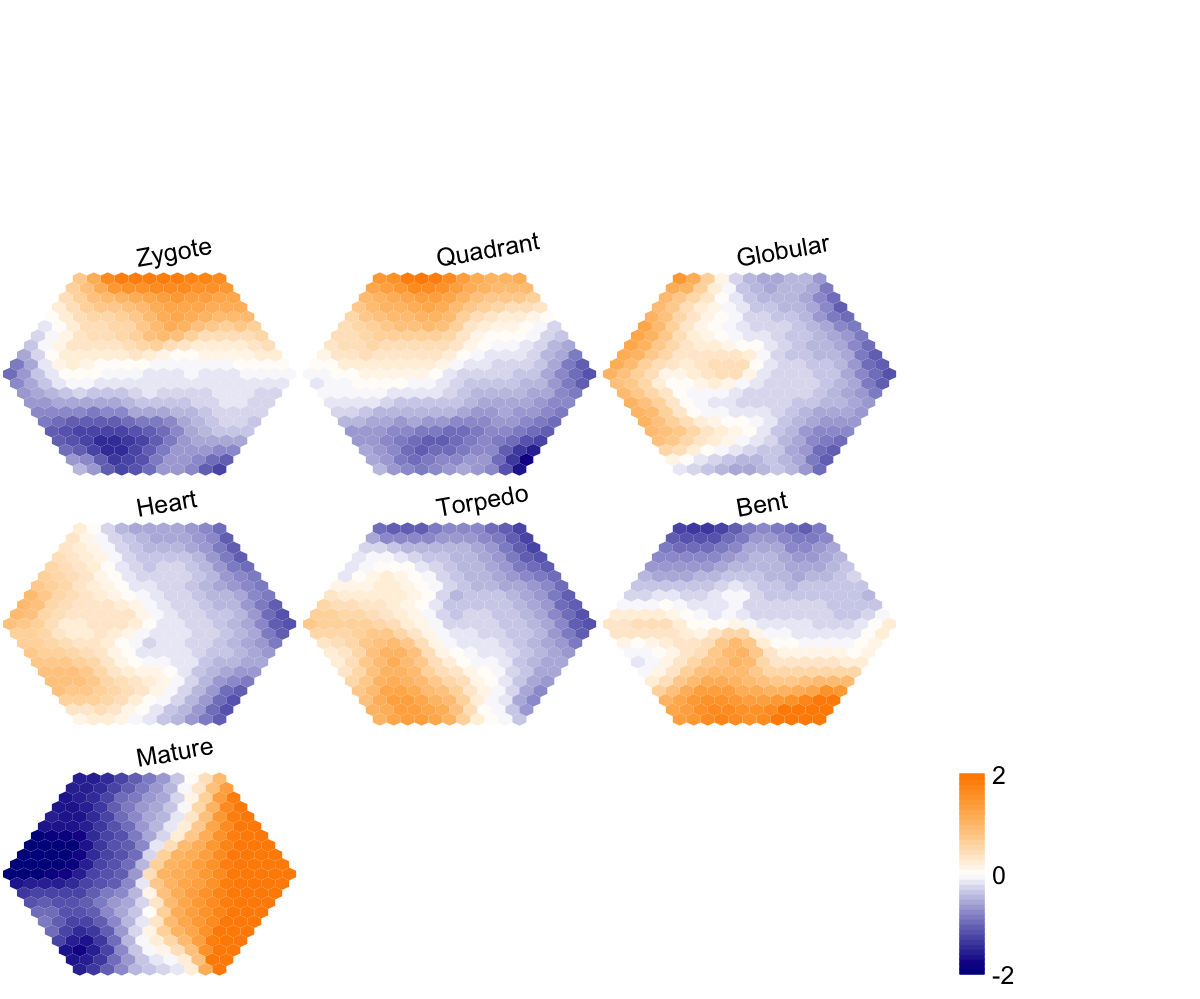
## As you have seen, a figure displays the multiple components of trained map in a sample-specific manner. You also see that a .txt file has been saved in your disk. The output file has 1st column for your input data ID (an integer; otherwise the row names of input data matrix), and 2nd column for the corresponding index of best-matching hexagons (i.e. gene clusters). You can also force the input data to be output; type ?
sWriteData for details.
# (III) Visualise the map, including built-in indexes, data hits/distributions, distance between map nodes, and codebook matrix
visHexMapping(sMap, mappingType="indexes")
## As you have seen, the smaller hexagons in the supra-hexagonal map are indexed as follows: start from the center, and then expand circularly outwards, and for each circle increase in an anti-clock order.
visHexMapping(sMap, mappingType="hits")
## As you have seen, the number represents how many input data vectors are hitting each hexagon, the size of which is proportional to the number of hits.
visHexMapping(sMap, mappingType="dist")
## As you have seen, map distance tells how far each hexagon is away from its neighbors, and the size of each hexagon is proportional to this distance.
visHexPattern(sMap, plotType="lines")
## As you have seen, line plot displays the patterns associated with the codebook matrix. If multple colors are given, the points are also plotted. When the pattern involves both positive and negative values, zero horizental line is also shown.
visHexPattern(sMap, plotType="bars",colormap="rainbow",legend.cex=0.5)
## As you have seen, bar plot displays the patterns associated with the codebook matrix. When the pattern involves both positive and negative values, the zero horizental line is in the middle of the hexagon; otherwise at the top of the hexagon for all negative values, and at the bottom for all positive values.
# (IV) Perform partitioning operation on the map to obtain continuous clusters (i.e. gene meta-clusters) as they are different from gene clusters in an individual map node
sBase <-
sDmatCluster(sMap, reindexSeed="svd")
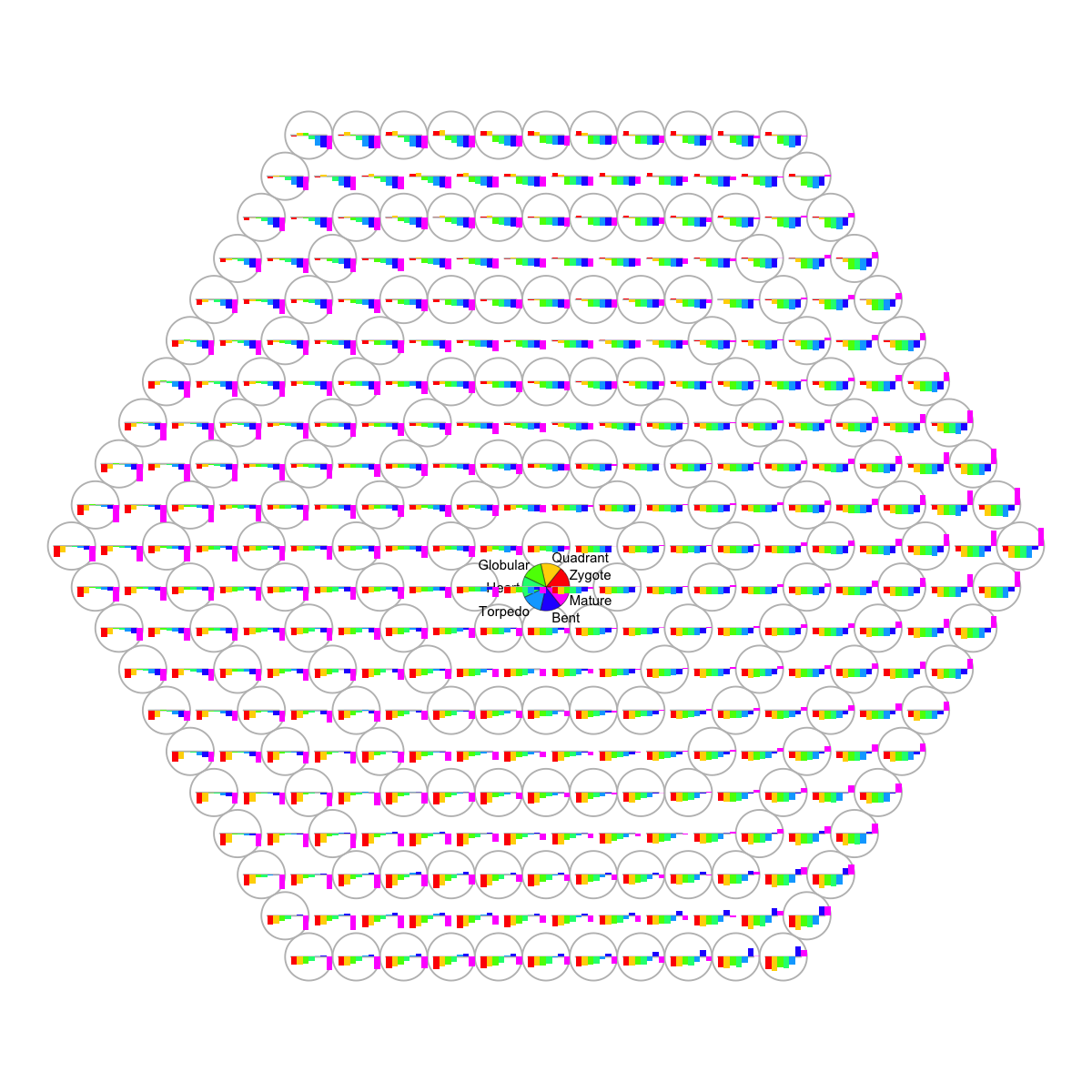
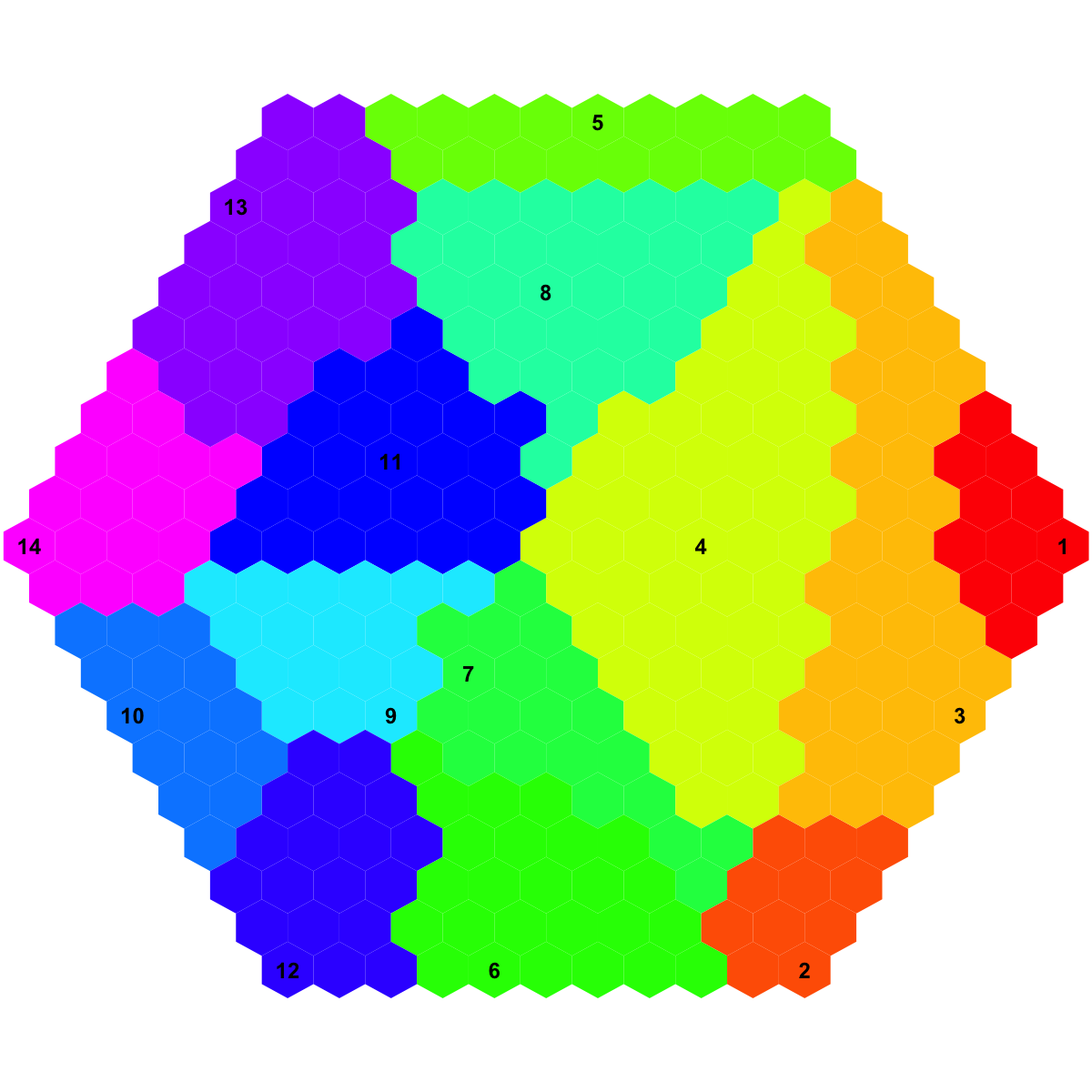
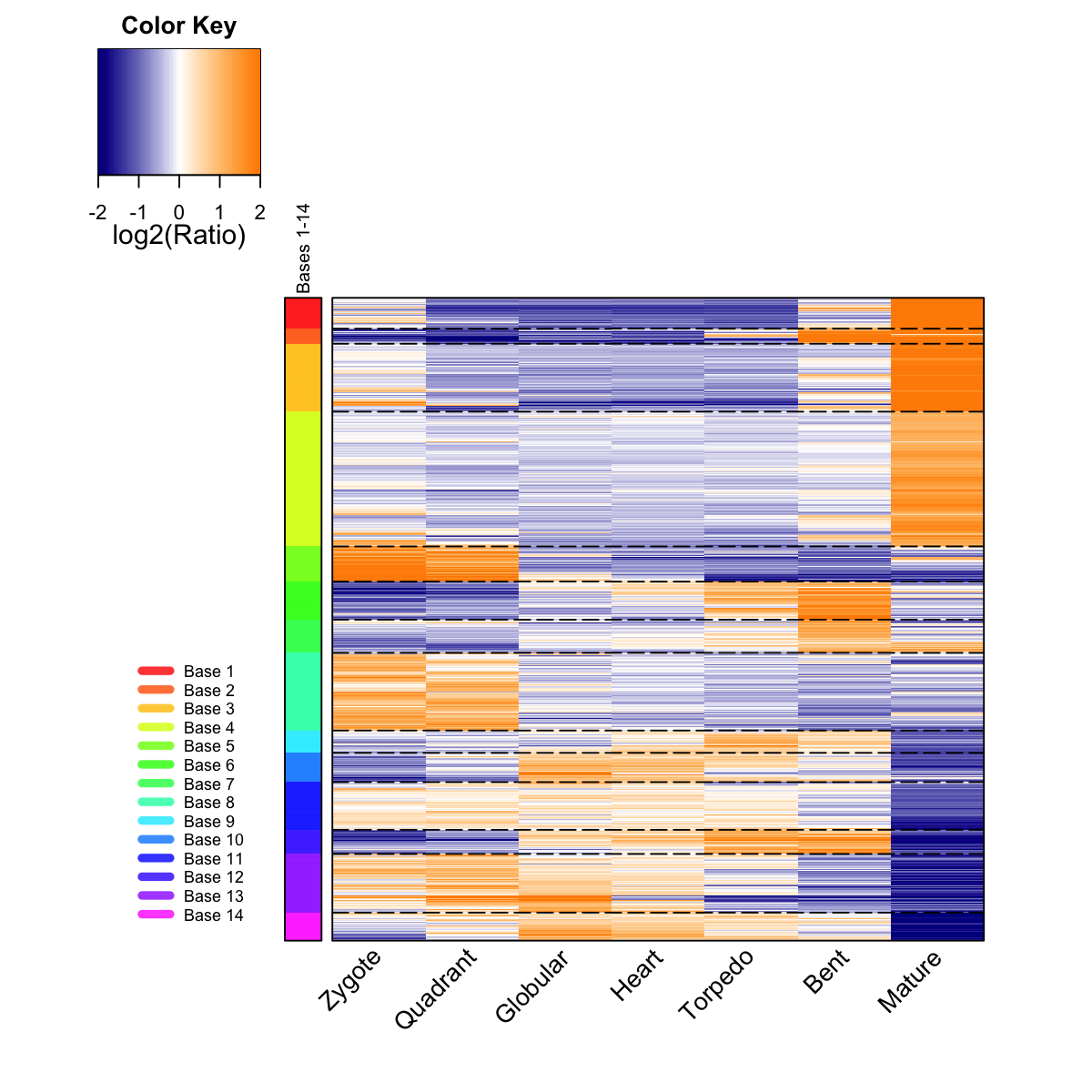 Start at 2016-06-24 11:46:22
First, define topology of a map grid (2016-06-24 11:46:22)...
Second, initialise the codebook matrix (20 X 7) using 'linear' initialisation, given a topology and input data (2016-06-24 11:46:22)...
Third, get training at the rough stage (2016-06-24 11:46:22)...
1 out of 203 (2016-06-24 11:46:22)
21 out of 203 (2016-06-24 11:46:22)
42 out of 203 (2016-06-24 11:46:22)
63 out of 203 (2016-06-24 11:46:22)
84 out of 203 (2016-06-24 11:46:22)
105 out of 203 (2016-06-24 11:46:22)
126 out of 203 (2016-06-24 11:46:22)
147 out of 203 (2016-06-24 11:46:22)
168 out of 203 (2016-06-24 11:46:22)
189 out of 203 (2016-06-24 11:46:22)
203 out of 203 (2016-06-24 11:46:22)
Fourth, get training at the finetune stage (2016-06-24 11:46:22)...
1 out of 805 (2016-06-24 11:46:22)
81 out of 805 (2016-06-24 11:46:22)
162 out of 805 (2016-06-24 11:46:22)
243 out of 805 (2016-06-24 11:46:22)
324 out of 805 (2016-06-24 11:46:22)
405 out of 805 (2016-06-24 11:46:22)
486 out of 805 (2016-06-24 11:46:22)
567 out of 805 (2016-06-24 11:46:22)
648 out of 805 (2016-06-24 11:46:22)
729 out of 805 (2016-06-24 11:46:22)
805 out of 805 (2016-06-24 11:46:22)
Next, identify the best-matching hexagon/rectangle for the input data (2016-06-24 11:46:22)...
Finally, append the response data (hits and mqe) into the sMap object (2016-06-24 11:46:22)...
Below are the summaries of the training results:
dimension of input data: 7x7
xy-dimension of map grid: xdim=5, ydim=4
grid lattice: rect
grid shape: sheet
dimension of grid coord: 20x2
initialisation method: linear
dimension of codebook matrix: 20x7
mean quantization error: 0.143266022604116
Below are the details of trainology:
training algorithm: sequential
alpha type: invert
training neighborhood kernel: gaussian
trainlength (x input data length): 29 at rough stage; 115 at finetune stage
radius (at rough stage): from 1 to 1
radius (at finetune stage): from 1 to 1
End at 2016-06-24 11:46:22
Runtime in total is: 0 secs
Start at 2016-06-24 11:46:22
First, define topology of a map grid (2016-06-24 11:46:22)...
Second, initialise the codebook matrix (20 X 7) using 'linear' initialisation, given a topology and input data (2016-06-24 11:46:22)...
Third, get training at the rough stage (2016-06-24 11:46:22)...
1 out of 203 (2016-06-24 11:46:22)
21 out of 203 (2016-06-24 11:46:22)
42 out of 203 (2016-06-24 11:46:22)
63 out of 203 (2016-06-24 11:46:22)
84 out of 203 (2016-06-24 11:46:22)
105 out of 203 (2016-06-24 11:46:22)
126 out of 203 (2016-06-24 11:46:22)
147 out of 203 (2016-06-24 11:46:22)
168 out of 203 (2016-06-24 11:46:22)
189 out of 203 (2016-06-24 11:46:22)
203 out of 203 (2016-06-24 11:46:22)
Fourth, get training at the finetune stage (2016-06-24 11:46:22)...
1 out of 805 (2016-06-24 11:46:22)
81 out of 805 (2016-06-24 11:46:22)
162 out of 805 (2016-06-24 11:46:22)
243 out of 805 (2016-06-24 11:46:22)
324 out of 805 (2016-06-24 11:46:22)
405 out of 805 (2016-06-24 11:46:22)
486 out of 805 (2016-06-24 11:46:22)
567 out of 805 (2016-06-24 11:46:22)
648 out of 805 (2016-06-24 11:46:22)
729 out of 805 (2016-06-24 11:46:22)
805 out of 805 (2016-06-24 11:46:22)
Next, identify the best-matching hexagon/rectangle for the input data (2016-06-24 11:46:22)...
Finally, append the response data (hits and mqe) into the sMap object (2016-06-24 11:46:22)...
Below are the summaries of the training results:
dimension of input data: 7x7
xy-dimension of map grid: xdim=5, ydim=4
grid lattice: rect
grid shape: sheet
dimension of grid coord: 20x2
initialisation method: linear
dimension of codebook matrix: 20x7
mean quantization error: 0.143266022604116
Below are the details of trainology:
training algorithm: sequential
alpha type: invert
training neighborhood kernel: gaussian
trainlength (x input data length): 29 at rough stage; 115 at finetune stage
radius (at rough stage): from 1 to 1
radius (at finetune stage): from 1 to 1
End at 2016-06-24 11:46:22
Runtime in total is: 0 secs
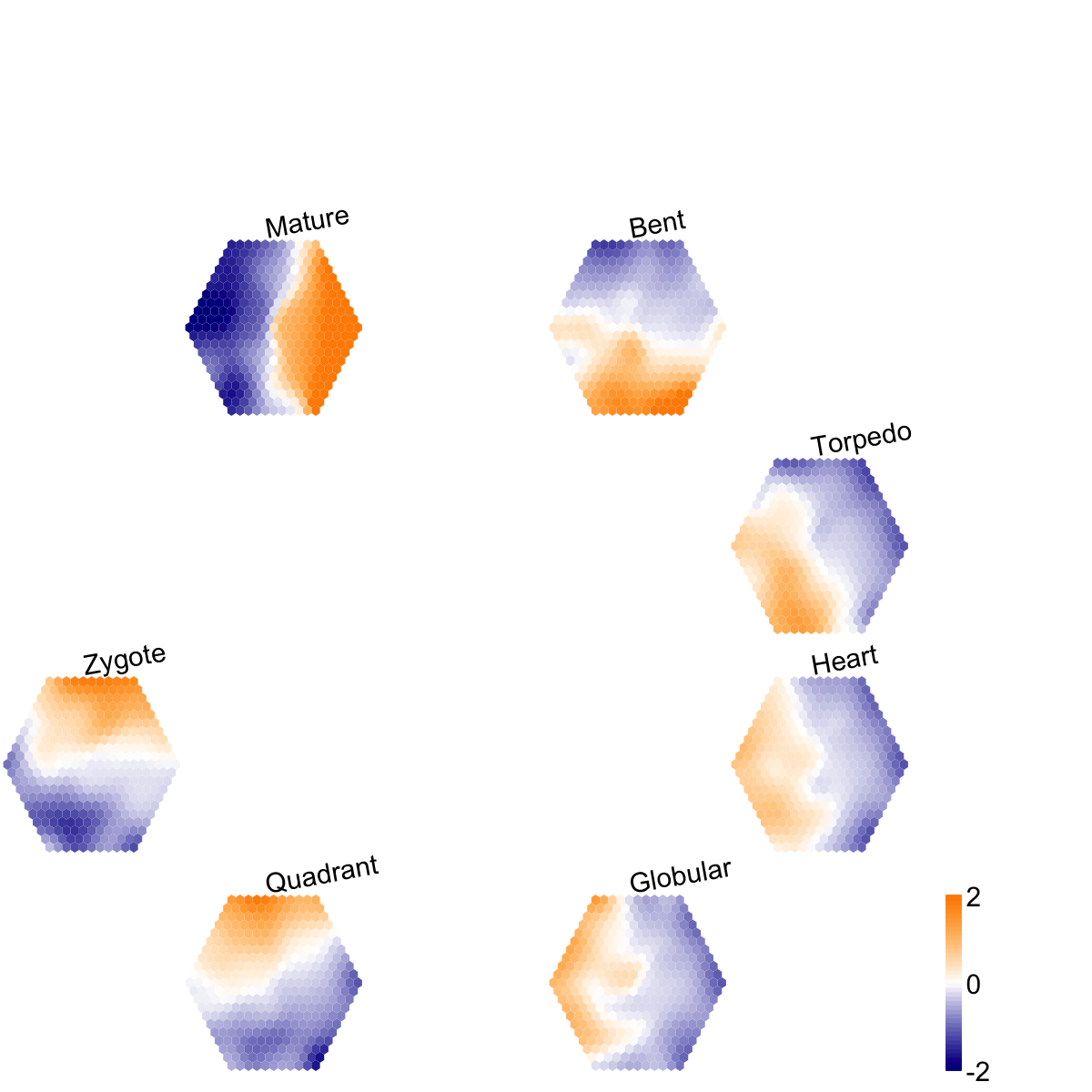
 ## As you have seen, a figure displays the multiple components of trained map in a sample-specific manner. You also see that a .txt file has been saved in your disk. The output file has 1st column for your input data ID (an integer; otherwise the row names of input data matrix), and 2nd column for the corresponding index of best-matching hexagons (i.e. gene clusters). You can also force the input data to be output; type ?sWriteData for details.
# (III) Visualise the map, including built-in indexes, data hits/distributions, distance between map nodes, and codebook matrix
visHexMapping(sMap, mappingType="indexes")
## As you have seen, the smaller hexagons in the supra-hexagonal map are indexed as follows: start from the center, and then expand circularly outwards, and for each circle increase in an anti-clock order.
visHexMapping(sMap, mappingType="hits")
## As you have seen, the number represents how many input data vectors are hitting each hexagon, the size of which is proportional to the number of hits.
visHexMapping(sMap, mappingType="dist")
## As you have seen, map distance tells how far each hexagon is away from its neighbors, and the size of each hexagon is proportional to this distance.
visHexPattern(sMap, plotType="lines")
## As you have seen, line plot displays the patterns associated with the codebook matrix. If multple colors are given, the points are also plotted. When the pattern involves both positive and negative values, zero horizental line is also shown.
visHexPattern(sMap, plotType="bars",colormap="rainbow",legend.cex=0.5)
## As you have seen, bar plot displays the patterns associated with the codebook matrix. When the pattern involves both positive and negative values, the zero horizental line is in the middle of the hexagon; otherwise at the top of the hexagon for all negative values, and at the bottom for all positive values.
# (IV) Perform partitioning operation on the map to obtain continuous clusters (i.e. gene meta-clusters) as they are different from gene clusters in an individual map node
sBase <- sDmatCluster(sMap, reindexSeed="svd")
## As you have seen, a figure displays the multiple components of trained map in a sample-specific manner. You also see that a .txt file has been saved in your disk. The output file has 1st column for your input data ID (an integer; otherwise the row names of input data matrix), and 2nd column for the corresponding index of best-matching hexagons (i.e. gene clusters). You can also force the input data to be output; type ?sWriteData for details.
# (III) Visualise the map, including built-in indexes, data hits/distributions, distance between map nodes, and codebook matrix
visHexMapping(sMap, mappingType="indexes")
## As you have seen, the smaller hexagons in the supra-hexagonal map are indexed as follows: start from the center, and then expand circularly outwards, and for each circle increase in an anti-clock order.
visHexMapping(sMap, mappingType="hits")
## As you have seen, the number represents how many input data vectors are hitting each hexagon, the size of which is proportional to the number of hits.
visHexMapping(sMap, mappingType="dist")
## As you have seen, map distance tells how far each hexagon is away from its neighbors, and the size of each hexagon is proportional to this distance.
visHexPattern(sMap, plotType="lines")
## As you have seen, line plot displays the patterns associated with the codebook matrix. If multple colors are given, the points are also plotted. When the pattern involves both positive and negative values, zero horizental line is also shown.
visHexPattern(sMap, plotType="bars",colormap="rainbow",legend.cex=0.5)
## As you have seen, bar plot displays the patterns associated with the codebook matrix. When the pattern involves both positive and negative values, the zero horizental line is in the middle of the hexagon; otherwise at the top of the hexagon for all negative values, and at the bottom for all positive values.
# (IV) Perform partitioning operation on the map to obtain continuous clusters (i.e. gene meta-clusters) as they are different from gene clusters in an individual map node
sBase <- sDmatCluster(sMap, reindexSeed="svd")
 visDmatCluster(sMap, sBase)
sWriteData(sMap, data, sBase, filename="Output_base_Xiang.txt", keep.data=T)
visDmatCluster(sMap, sBase)
sWriteData(sMap, data, sBase, filename="Output_base_Xiang.txt", keep.data=T)
 ## As you have seen, each cluster is filled with the same continuous color, and the cluster index is marked in the seed node. Although different clusters are coded using different colors (randomly generated), it is unavoidable to have very similar colors filling in neighbouring clusters. In other words, neighbouring clusters are visually indiscernible. In this confusing situation, you can rerun the command visDmatCluster(sMap, sBase) until neighbouring clusters are indeed filled with very different colors. An output .txt file has been saved in your disk. This file has 1st column for your input data ID (an integer; otherwise the row names of input data matrix), and 2nd column for the corresponding index of best-matching hexagons (i.e. gene clusters), and 3rd column for the cluster bases (i.e. gene meta-clusters). You can also force the input data to be output; type ?sWriteData for details.
output <- visDmatHeatmap(sMap, data, sBase, base.separated.arg=list(col="black"), base.legend.location="bottomleft", colormap="darkblue-white-darkorange", KeyValueName="log2(Ratio)", labRow=NA, keep.data=T)
## As you have seen, each cluster is filled with the same continuous color, and the cluster index is marked in the seed node. Although different clusters are coded using different colors (randomly generated), it is unavoidable to have very similar colors filling in neighbouring clusters. In other words, neighbouring clusters are visually indiscernible. In this confusing situation, you can rerun the command visDmatCluster(sMap, sBase) until neighbouring clusters are indeed filled with very different colors. An output .txt file has been saved in your disk. This file has 1st column for your input data ID (an integer; otherwise the row names of input data matrix), and 2nd column for the corresponding index of best-matching hexagons (i.e. gene clusters), and 3rd column for the cluster bases (i.e. gene meta-clusters). You can also force the input data to be output; type ?sWriteData for details.
output <- visDmatHeatmap(sMap, data, sBase, base.separated.arg=list(col="black"), base.legend.location="bottomleft", colormap="darkblue-white-darkorange", KeyValueName="log2(Ratio)", labRow=NA, keep.data=T)
 ## As you have seen, heatmap is used to visualise patterns seen in genes within each meta-cluster/base. Row side bar indicates the meta-clusters/bases. The returned variable "output" (NOT a txt file) has 1st column for your input data ID (an integer; otherwise the row names of input data matrix), and 2nd column for the corresponding index of best-matching hexagons (i.e. gene clusters), and 3rd column for the cluster bases (i.e. gene meta-clusters). Note: it has rows in the same order as visualised in the heatmap
# (V) Reorder the sample-specific components of the map to delineate relationships between samples
sReorder <- sCompReorder(sMap, metric="pearson")
Start at 2016-06-24 11:46:22
First, define topology of a map grid (2016-06-24 11:46:22)...
Second, initialise the codebook matrix (20 X 7) using 'linear' initialisation, given a topology and input data (2016-06-24 11:46:22)...
Third, get training at the rough stage (2016-06-24 11:46:22)...
1 out of 203 (2016-06-24 11:46:22)
21 out of 203 (2016-06-24 11:46:22)
42 out of 203 (2016-06-24 11:46:22)
63 out of 203 (2016-06-24 11:46:22)
84 out of 203 (2016-06-24 11:46:22)
105 out of 203 (2016-06-24 11:46:22)
126 out of 203 (2016-06-24 11:46:22)
147 out of 203 (2016-06-24 11:46:22)
168 out of 203 (2016-06-24 11:46:22)
189 out of 203 (2016-06-24 11:46:22)
203 out of 203 (2016-06-24 11:46:22)
Fourth, get training at the finetune stage (2016-06-24 11:46:22)...
1 out of 805 (2016-06-24 11:46:22)
81 out of 805 (2016-06-24 11:46:22)
162 out of 805 (2016-06-24 11:46:22)
243 out of 805 (2016-06-24 11:46:22)
324 out of 805 (2016-06-24 11:46:22)
405 out of 805 (2016-06-24 11:46:22)
486 out of 805 (2016-06-24 11:46:22)
567 out of 805 (2016-06-24 11:46:22)
648 out of 805 (2016-06-24 11:46:22)
729 out of 805 (2016-06-24 11:46:22)
805 out of 805 (2016-06-24 11:46:22)
Next, identify the best-matching hexagon/rectangle for the input data (2016-06-24 11:46:22)...
Finally, append the response data (hits and mqe) into the sMap object (2016-06-24 11:46:22)...
Below are the summaries of the training results:
dimension of input data: 7x7
xy-dimension of map grid: xdim=5, ydim=4
grid lattice: rect
grid shape: sheet
dimension of grid coord: 20x2
initialisation method: linear
dimension of codebook matrix: 20x7
mean quantization error: 0.143266022604116
Below are the details of trainology:
training algorithm: sequential
alpha type: invert
training neighborhood kernel: gaussian
trainlength (x input data length): 29 at rough stage; 115 at finetune stage
radius (at rough stage): from 1 to 1
radius (at finetune stage): from 1 to 1
End at 2016-06-24 11:46:22
Runtime in total is: 0 secs
visCompReorder(sMap,sReorder,title.rotate=10,colormap="darkblue-white-darkorange")
## As you have seen, reordered components of trained map is displayed. Each component illustrates a sample-specific map and is placed within a two-dimensional rectangular lattice. Across components/samples, genes with similar expression patterns are mapped onto the same position of the map. Geometric locations of components delineate relationships between components/samples, that is, samples with the similar expression profiles are placed closer to each other.
## As you have seen, heatmap is used to visualise patterns seen in genes within each meta-cluster/base. Row side bar indicates the meta-clusters/bases. The returned variable "output" (NOT a txt file) has 1st column for your input data ID (an integer; otherwise the row names of input data matrix), and 2nd column for the corresponding index of best-matching hexagons (i.e. gene clusters), and 3rd column for the cluster bases (i.e. gene meta-clusters). Note: it has rows in the same order as visualised in the heatmap
# (V) Reorder the sample-specific components of the map to delineate relationships between samples
sReorder <- sCompReorder(sMap, metric="pearson")
Start at 2016-06-24 11:46:22
First, define topology of a map grid (2016-06-24 11:46:22)...
Second, initialise the codebook matrix (20 X 7) using 'linear' initialisation, given a topology and input data (2016-06-24 11:46:22)...
Third, get training at the rough stage (2016-06-24 11:46:22)...
1 out of 203 (2016-06-24 11:46:22)
21 out of 203 (2016-06-24 11:46:22)
42 out of 203 (2016-06-24 11:46:22)
63 out of 203 (2016-06-24 11:46:22)
84 out of 203 (2016-06-24 11:46:22)
105 out of 203 (2016-06-24 11:46:22)
126 out of 203 (2016-06-24 11:46:22)
147 out of 203 (2016-06-24 11:46:22)
168 out of 203 (2016-06-24 11:46:22)
189 out of 203 (2016-06-24 11:46:22)
203 out of 203 (2016-06-24 11:46:22)
Fourth, get training at the finetune stage (2016-06-24 11:46:22)...
1 out of 805 (2016-06-24 11:46:22)
81 out of 805 (2016-06-24 11:46:22)
162 out of 805 (2016-06-24 11:46:22)
243 out of 805 (2016-06-24 11:46:22)
324 out of 805 (2016-06-24 11:46:22)
405 out of 805 (2016-06-24 11:46:22)
486 out of 805 (2016-06-24 11:46:22)
567 out of 805 (2016-06-24 11:46:22)
648 out of 805 (2016-06-24 11:46:22)
729 out of 805 (2016-06-24 11:46:22)
805 out of 805 (2016-06-24 11:46:22)
Next, identify the best-matching hexagon/rectangle for the input data (2016-06-24 11:46:22)...
Finally, append the response data (hits and mqe) into the sMap object (2016-06-24 11:46:22)...
Below are the summaries of the training results:
dimension of input data: 7x7
xy-dimension of map grid: xdim=5, ydim=4
grid lattice: rect
grid shape: sheet
dimension of grid coord: 20x2
initialisation method: linear
dimension of codebook matrix: 20x7
mean quantization error: 0.143266022604116
Below are the details of trainology:
training algorithm: sequential
alpha type: invert
training neighborhood kernel: gaussian
trainlength (x input data length): 29 at rough stage; 115 at finetune stage
radius (at rough stage): from 1 to 1
radius (at finetune stage): from 1 to 1
End at 2016-06-24 11:46:22
Runtime in total is: 0 secs
visCompReorder(sMap,sReorder,title.rotate=10,colormap="darkblue-white-darkorange")
## As you have seen, reordered components of trained map is displayed. Each component illustrates a sample-specific map and is placed within a two-dimensional rectangular lattice. Across components/samples, genes with similar expression patterns are mapped onto the same position of the map. Geometric locations of components delineate relationships between components/samples, that is, samples with the similar expression profiles are placed closer to each other.
